
Entenda como a Digibee usa lógica simplificada e arquitetura orientada a eventos para criar integrações rápidas e confiáveis com este pequeno vídeo do nosso produto para desenvolvedores.

Entenda como a Digibee usa lógica simplificada e arquitetura orientada a eventos para criar integrações rápidas e confiáveis com este pequeno vídeo do nosso produto para desenvolvedores.

Saiba como o Digibee está reimaginando as integrações, permitindo a reutilização de código e lógica com “cápsulas”. Ao encapsular as bibliotecas de código a serem usadas e reutilizadas nas integrações, as cápsulas da Digibee fornecem poder de API com simplicidade semelhante à função.
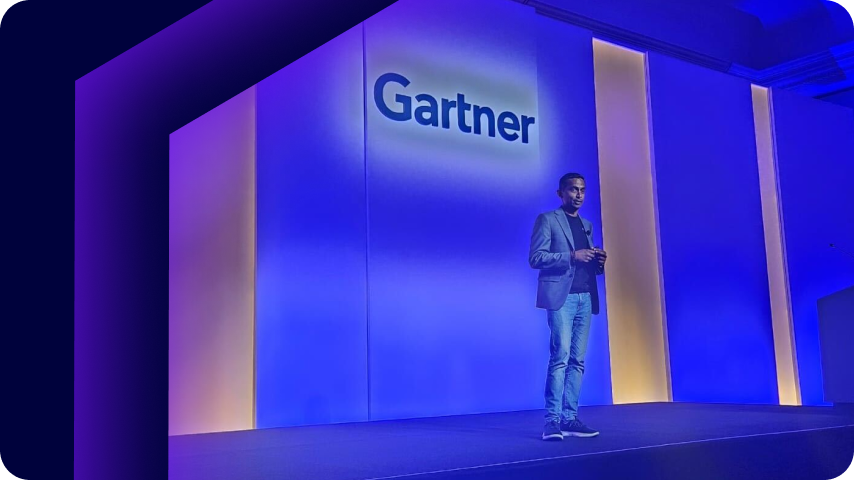
Tive a honra de apresentar em nome da Digibee no Gartner Innovation & Business Solutions Summit deste ano em Las Vegas, abordando mais de 150 líderes de diversos setores e áreas técnicas. Mostrar o produto da Digibee é sempre um prazer, mas apresentar um estudo de caso de cliente é ainda melhor. Especialmente quando os resultados mostrados mostraram reduções drásticas no esforço e custo geral.
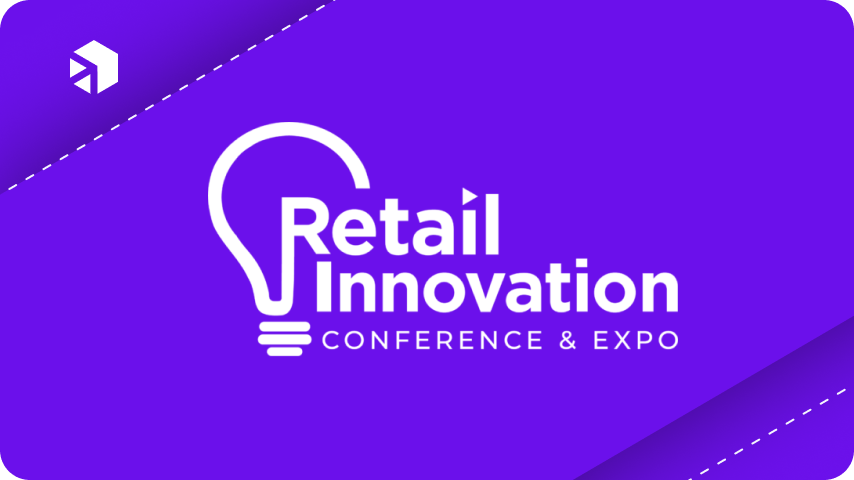
EVENTO: Retail Innovation Conference & Expo (R.I.C.E.)
QUANDO: 4 a 6 de junho de 2024< br>ONDE: McCormick Place, Chicago
COMO NOS ENCONTRAR: Visite o estande nº 527
A Digibee se juntará a líderes e diretores de varejo para destacar como nosso iPaaS inovador e econômico acelera os resultados de negócios com facilidade e escalabilidade. Na verdade, nossa solução integrou uma plataforma segura de comércio eletrônico em mais de 200 lojas, em 15 países, em menos de 30 dias por Sem pagamento.
Nossos especialistas em integração estarão no estande #527 para discutir tudo sobre integração para negócios de varejo. Ouça em primeira mão como nosso poderoso produto oferece uma abordagem rápida, eficiente, econômica e simplificada para os desafios modernos de integração. Obtenha pessoalmente uma visão geral abrangente, agendar uma demonstração para conversar com nossa equipe sobre seus casos de uso e desafios de negócios ou sinal teste nosso produto e veja você mesmo a facilidade e a experiência intuitiva do usuário.
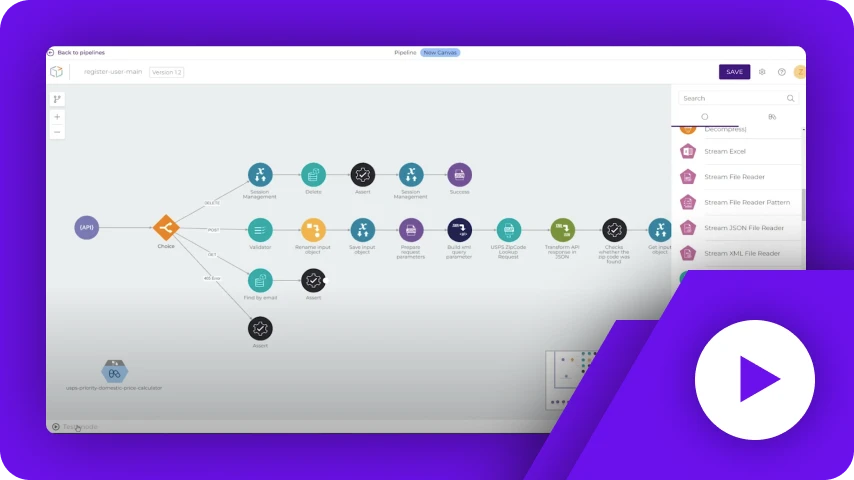
evento : Digibee’s Live Demo Series
Quando: quintas-feiras, 12:00 (ET)
Onde: Online
registre : Registre -se aqui
Saiba como o IPAAS da Digibee está reimaginando a abordagem das soluções de integração modernas. Obtenha uma visão abrangente de nossa poderosa plataforma sem o compromisso de uma chamada formal.
Aqui está o que esperar:

In today’s fast-paced business landscape, the need for seamless communication and data flow between various systems within an organization has become paramount. Gone are the days of siloed information and disjointed processes that hinder productivity and innovation. The solution? Business system integrations.
Before diving too deeply – it is important to understand the “before” state for organizations’ lacking system integration and the pain points they often bring. Lacking business integration commonly includes challenges such as fragmented data silos, inefficient workflows, manual data entry errors, and the inability to adapt to evolving business needs swiftly.
These pain points not only hamper operational efficiency, but also hinder strategic decision-making and impede overall growth.
In this comprehensive guide, we’ll cover the intricacies of business system integrations, from understanding pain points driving organizations to integrate different systems, the options for system integration, to exploring the key steps and considerations involved in the implementation process.
Key Points
>> Book a personalized demo with our team of experts and see how Digibee’s iPaaS will bring efficiency to your business.
At its core, business systems integration refers to the process of connecting disparate systems and applications within an organization to streamline and simplify data flowing from one place to another.
The ultimate goal is to create a cohesive ecosystem where data flows seamlessly between internal IT systems and third-party applications. This functionality ultimately fosters improved collaboration, efficiency, and decision-making capabilities.
Business systems integration encompasses various types of systems, including but not limited to:
Application Programming Interfaces (APIs) and connectors play a crucial role in facilitating seamless data exchange between these different systems. APIs allow systems to communicate with each other, enabling the transfer of information in a standardized data format, while connectors act as bridges between incompatible systems, ensuring smooth integration.
While there are numerous integration models and methods – hub and spoke, point-to-point, star integration, and ESB – three primary types are to be considered:
The benefits of systems integrations are extensive and should be carefully considered for organizations looking to achieve interconnectivity for a variety of reasons:
By eliminating manual data entry and minimizing errors, integrations ensure that data remains accurate and consistent across systems.
Integrations streamline workflows and automate repetitive tasks, boosting productivity and reducing turnaround times.
Integrated systems can easily scale to accommodate growing business needs, retire legacy systems, and keep pace with new technology requirements.
By streamlining processes and improving efficiency, integrations help organizations lower operational costs and optimize resource utilization.
Seamless integrations enable organizations to deliver personalized and timely experiences to customers by providing businesses with a 360 customer view, enhancing customer satisfaction and loyalty.
Integrations facilitate regulatory compliance by ensuring data integrity and security – thereby reducing the risk of non-compliance penalties.
Before embarking on a business systems integration journey or any integration project, organizations should undertake the following steps:
While organizations have the option to build integration solutions from scratch, there are plenty of vendors, like Digibee, that offer a best-in-class SaaS solution. When evaluating purchasing integration solutions, consider the following key features:
As organizations navigate the complexities of business systems integrations, partnering with a trusted integration platform provider like Digibee can streamline the process and drive success.
Digibee is a powerful iPasS that simplifies the integration of disparate business systems and applications. The most efficient, scalable way to facilitate integration projects is with an integration platform as a service, or iPaaS, such as Digibee.
An iPaaS is a platform developers use to build and manage integrations on scalable architecture—it replaces outdated integration options like ESB and includes features like reusable components, a low-code interface, managed infrastructure, prebuilt integrations, and enterprise support.
Unlike some of its predecessors, Digibee’s iPaaS doesn’t require specialized training or a long implementation. On the contrary, it speeds up digital transformation projects by automating and simplifying the development workflows needed to connect legacy systems and cloud applications in one unified system.
Digibee is different in that it is the only integration platform that scales application integration workflows while reducing cost, technical debt, and the burden on development teams. It allows developers to quickly build, test, deploy, govern, and monitor integrations across on-premises systems and cloud environments—they can then use the platform in tandem with API management and ETL tools for full synchronization across the organization.
Digibee is a born-in-the-cloud integration platform, that modernizes how enterprises connect applications, data, processes, and people. The integration platform includes:
Digibee has helped numerous organizations streamline operations, enhance efficiency, and drive innovation through integration across a multitude of industries including retail, manufacturing, and hospitality:
In conclusion, business systems integrations offer a myriad of benefits, from improving efficiency and data accuracy to enhancing customer experiences and ensuring compliance. By following the key steps outlined in this guide and evaluating integration solutions with care, organizations can embark on a successful integration journey that drives growth, innovation, and competitive advantage.
Ready to revolutionize your business systems integration journey? Schedule a demo or, if you prefer, take a tour of Digibee’s platform to discover how it can help with system connectivity in your own organization.
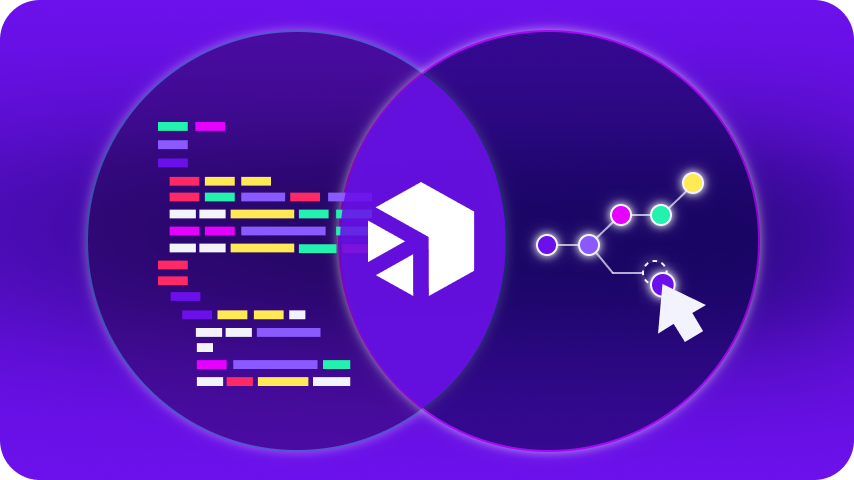
Sem mundo da interração, como empresas Enfrentam um dilema comum. Escolha Um ipaas (Planora de Integracão Como Serviço) Empresariano Poderoso, Massia Complexo e Caro, Com Retorno Lento, Opte por UM Forneceder de Autommaço Que Prove O Resultado ResultA.
Este Tem Sido o Cenário: Uma Escolha Entre Duas OpÇões Imperfeitas.
soluções empresariais ipaas , Embora robustas, Apropriemam benéficos significativos. Eles São complexos, desativam implicações demoradas e caras que podem Levar Mesas Antes de Produzir Resultados. A ESSA Complexidada Muitas vezes exige um contato de consultores externos, um luxu que até mesmo como maiiorres corporações podem pagar. Além Disso, ESSAS PLATAFORSAS tendem um você prender. Perto de mais você investte, mais difícia se tornar, prendendo você em um ciclo de custos irrecuperáveis.
Os
forçadores de automático , posicionados sem o extirmo do especial, o ofrecem uma alternativa adequada com suá implica rápida e custos iniciais iniciais. Porém, ESSA VANTAGEM É PASSAGEIRA. À medida que uma necessidade de personalização aumumenta, tamboma aumenta os custos e como complicações, minando quaisquer gânias iniciais e empurrando você de volta ao cenário de alta e alta e altA
UM Digibee Presta Muita Atenção> E construiu uma solução que um abordenado de Frente, postionando-se em uma posição positiva positiva Única no quadrante ipaas.
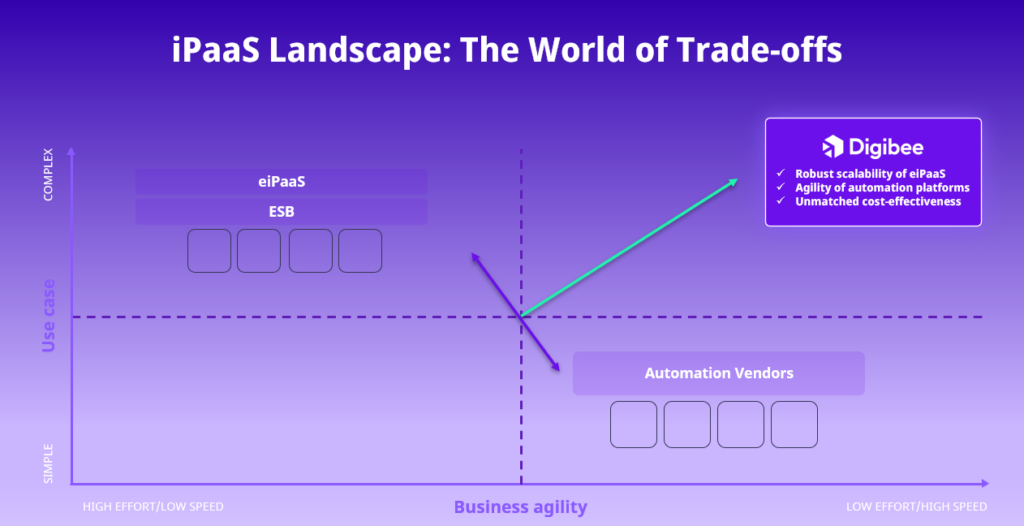
>> agenda uma demonstração personalizada com Nossa Equipe de Especialistas e Veja Como a A Um Um Digibee Funciona iPaas Trazendo Eficiênia Ao Seu Negócio.
uma perspectiva de um digibee Apresta Uma Nova, Ofrecendo uma plataforma que combina a robustez das soluções empresesa Veja Como:
integracão sem ESPERA: Digibee Acelera a integracão por meio de blocos de construção reutilizáveis ( efici ênncia impulsão por ia: uma plataforma Mitigar O Risco de Aprisionamento do Fornecder .
o Mercado Ipaas há muito Aprepenta às Empreas Uma Escolha Dificil: capacidada versus Custo-Benefio, Escalabilidada versus Velocidade. Com digibee, uma era de compromisso chegou ao fim. Não se Trata de Apeenas da Sistemas do Conectar; Possibilidades de trata-se de dessbloquear, simplificar uma complexidada e priorizar sua necessidade e pré-cada cada passo.
uma solução da digibee atende diretamenthe ao Princípio necessidade daas empreas que navegam não complexo cenário ipaas. OFERECE Uma forma de integração Profunda e flexível, sem compensa compensações de Custo tradicionais, complexidade ou velocidada.
Ao abordo Essera Pontos críticos, um digibee de -receita uma plathaforma onde como empreas podem construir e dimensionar suas integracõe com confiança, reivindicada pelo suporte e flexibilidade necessariamente.

Muitos usuários Legados de Ipaas, como você, Enfrentam Obstáculos Comunos. Essesfios vão Desde de Fim do Suporte com Seu Fornecedor ATUAL, ATÉ UMA NECESSÁRIO DE MODERNIZAR SUA SUA ARQUITETURA PARA APOIAR NOVAS Tecnologias, Até Uma Além Disso, Enquanto UM Equipe Sobrecarregada Luta para Gerenciar Como Integrações
o resultado? Eles ficam presos a uma solução que prejudica sua capacidade de posicionar Seus Negócios para Crescimentação e Inovação Futura.
Sem Mercados em Rápida Evolução, como empresas até priorizar uma agilidade para mangue Uma competitividade bordada . Uma Maneira de apoiar essa agilidade é capacitar como equipamentos de descrenvolimento
No Vídeo Abaixo, Dave, Desenvolvedor de Ipaas Legado, Compartilheiro Muitos Deiss Pontos Problemáticos Comunos com um especialista em interranaço, dra. Sara. Na última análise, ela especifica Digibee para Capacitar dave e sua equipe UM fornece integrações críticas /a>.
se você se sente -se -se -se -preconcado por uma plataforma de integração legada, talvez seja hora de considerar mudar para um soluções moderna> .
receba uma demonstração personalizada de nossa Equipe de Especialistas e Deixe-Nos Orientá-Lo Sobre Como Podemos Aborda Um Deles Seus Pontos Fracos com Nossa Abordagem de Integração Simples, Rápida e Moderna.

Enfrentando noites sem dormir e frustração com problemas causados pela sua solução de integração legada? Pode ser mais fácil do que você pensa mudar para um iPaaS moderno.

Olha, sabemos que términos nunca são fáceis. Mas quantas vezes, em retrospectiva, sabemos que não apenas fizemos a coisa certa, mas que deveríamos ter feito isso antes? É assim que os clientes da Digibee se sentem quando finalmente decidem se livrar do seu iPaaS legado e adotar a plataforma moderna e serverless da Digibee.
Os nossos clientes têm uma infinidade de razões para trocar: fim do suporte de uma solução legado, implantação de uma nova tecnologia que exige uma arquitetura moderna, equipes de TI sobrecarregadas gerenciando integrações que fazem o trabalho prioritário se acumular, ou os custos crescentes de atualização e suporte que agregam pouco ou nenhum valor.
Independentemente do motivo, adiar o inevitável impede a verdadeira escalabilidade, desacelera o crescimento, prejudica a moral e, no final, impacta seu resultado final. Está na hora de seguir em frente. O iPaaS da Digibee não só capacita sua equipe de desenvolvimento e maximiza suas capacidades, mas também permite sua transição de forma rápida, econômica e sem desgostos. Sério.
>> Agende uma demonstração personalizada com nossa equipe de especialistas e veja como o iPaaS da Digibee trará eficiência para o seu negócio.
Mudanças são muitas vezes inevitáveis – você pode escolher se preparar para elas ou escolher reagir a elas. Já ouvimos todas as razões que impedem as organizações de deixarem seu relacionamento co-dependente com o iPaaS legado. Não estamos fingindo que elas não são válidas, mas fazer a mudança com a Digibee pode não ser tão difícil quantovocê imagina.
Listamos abaixo alguns desses “problemas de relacionamento”. Se algum deles ressoar com você, fale com nossa equipe. Podemos resolver cada uma de suas preocupações e tranquilizá-lo, planejando sua possível substituição e avançando com uma parceria de integração mais saudável.
Você está com sua solução legado há muito tempo. Você tem entendimento sobre ela e deixar tudo isso para trás parece ser muito disruptivo. “Estamos bem. Está tudo bem. Eu estou bem.” Isso soa familiar?
Muito profissionais de tecnologia perderam o sono por causa de substituições tecnológicas que se mostraram tão difíceis de implementar que a nova solução ficou abaixo das expectativas. Claro, a mudança pode ser difícil, mas a realidade é que ignorar a mudança necessária pode fazer sua organização ficar estagnada – arriscando o crescimento e a inovação necessários para ter sucesso e se destacar diante dos concorrentes.
Mas sabemos como funciona. Com as equipes de TI já sobrecarregadas, a decisão de substituir uma tecnologia “boa o suficiente” precisa ser justificada com uma razão inegável para agir e um resultado de negócios claro e quantificável. Muitas vezes, as organizações não buscam uma solução alternativa até que uma crise chegue e tome a decisão por elas.
Trocar de fornecedor é um investimento e você precisa de garantias de que as interrupções e o tempo de inatividade serão mínimos. O modelo de implementação da Digibee minimiza o tempo de inatividade e inclui o onboarding rápido de sua equipe para que ela possa ser produtiva quase imediatamente. Já mencionamos que já fizemos isso antes?
Você tem criado código com essa solução por anos, há muita história e tempo investido. Como pode simplesmente deixar tudo isso para trás?
O simples pensamento de abandonar sua solução interna existente e todas as suas interconexões e personalizações te dá tanta ansiedade que parece mais fácil continuar do que mudar. A solução da Digibee não é apenas robusta e escalável, mas também é low-code e componível. O gerenciamento de mudanças é fácil e repetível, então sua equipe de desenvolvimento não precisa continuar pelo caminho usual de constantes personalizações e código emaranhado.
O iPaaS da Digibee capacita todos os desenvolvedores – não apenas os especialistas em integração – a criar e monitorar integrações de forma fácil. Somos a primeira plataforma iPaaS serverless. Nossa arquitetura nasceu na nuvem e é construída sobre microserviços. Você pode deixar a complexidade para trás e se posicionar para um futuro já projetado para ser escalável e crescer conforme o seu negócio cresce.
Você escolheu seu produto de integração existente por um motivo. Abrir-se para um novo fornecedor, especialmente quando já tem um, pode parecer mais uma dor de cabeça, mas pode ser a solução que você precisa para aliviar seus problemas.
Às vezes, a solução certa é um modelo híbrido, onde a Digibee trabalha em conjunto com sua plataforma existente. Nossa equipe dedicará tempo para entender a razão e o propósito de sua solução atual. Qualquer que seja a solução que melhor atenda às necessidades de sua organização, a equipe da Digibee pode orientá-lo passo a passo sobre como abordar cada uma de suas preocupações e apoiar todos os aspectos da sua transição.
Você investiu tanto (tanto) nessa relação. É difícil justificar o investimento em outra solução quando, tecnicamente, você já tem uma.
Sabemos que os orçamentos estão apertados na economia atual. Deixe nossa equipe te guiar em uma análise detalhada de ROI que explore os prós e contras dos gastos com sua solução atual em comparação com a Digibee. A realidade, muitas vezes, é que as economias de tempo, recursos e dinheiro que uma substituição ou coexistência de iPaaS pode trazer podem ser significativas para o seu negócio.
Soluções iPaaS modernas como a nossa são realmente extremamente econômicas, especialmente em comparação com soluções legadas. A transição de uma solução on-prem para uma solução em nuvem também transforma seu investimento de CapEx para OpEx, o que traz benefícios financeiros adicionais. E, nosso modelo de precificação direto e transparente inclui onboarding, implementação e serviços de suporte. Podemos capacitar sua equipe a entregar em apenas seis semanas ou menos.
Se você está cansado de se sentir preso em um relacionamento legado (e não dissemos parceria por um motivo) e está procurando planejar os próximos passos para o seu negócio, adoraríamos ouvir de você.
Entre em contato com nossa equipe hoje e deixe-nos mostrar como podemos resolver cada um dos seus pontos críticos com nossa abordagem simples, rápida e moderna para integrações.

Como líder de negócios e tecnologia, algumas das decisões tecnológicas mais críticas que você enfrenta giram em torno de adotar amplamente uma suíte integrada de um único fornecedor ou montar uma pilha “best-of-breed” (melhor da categoria) de ferramentas especializadas.
O conjunto de decisões associado é a base da sua estratégia tecnológica, e as escolhas que você faz terão um impacto profundo na flexibilidade, inovação e custos da sua pilha de tecnologia à medida que sua organização cresce, escala e evolui.
>> Agende uma demonstração personalizada com nossa equipe de especialistas e veja como o iPaaS da Digibee trará eficiência para o seu negócio.

Chegamos a reconhecer a mudança na expressão facial.
Aqui na Digibee, participamos de muitos eventos tecnológicos presenciais. A mudança de expressão que mencionei acima geralmente segue um padrão. Primeiro, iniciamos uma conversa com um participante do evento, falamos sobre a iPaaS sem servidor da Digibee, a capacidade dos nossos usuários de escalar de forma contínua para cima ou para baixo, nossas capacidades orientadas a eventos, e fazemos uma demonstração rápida ao vivo da interface da nossa iPaaS.
Literalmente, vemos o interesse crescer conforme falamos. Então, a mudança acontece: “Ah, espera, já usamos XYZ para integração.”
Com certeza, sua organização está usando algo para integração. Com o número médio de aplicativos SaaS já ultrapassando 100 implementações (e crescendo) em muitas organizações – sem contar os vários sistemas, fontes de dados e APIs que você tem em produção – é muito provável que você esteja usando alguma combinação de iPaaS, tecnologia de automação, ESBs, middleware e codificação interna para juntar tudo.
Estamos bem cientes da relutância em adicionar mais ferramentas ou substituir tecnologias instaladas. Você precisa ter certeza de que não está apenas adicionando mais complexidade ao que já deve parecer um espalhamento tecnológico insustentável. Uma ferramenta a mais e uma linha de orçamento a mais exigem que o valor seja validado.
A tecnologia de integração deve empoderar os desenvolvedores… mas, no meio de todo esse espalhamento, muitas vezes ela se torna o gargalo da produtividade. E, ainda assim, os pontos de dor associados aos diversos provedores legados de iPaaS são reais. A tecnologia de integração, quando realmente funciona como foi planejada, deve permitir que desenvolvedores e arquitetos inovem e construam. Existe uma maneira melhor.
Então, voltando ao participante do evento que estava animado com a Digibee até perceber que sua organização já tinha uma solução de integração implementada. Isso soa como o fim da conversa, mas é realmente onde a nossa conversa começa. Na verdade, a maioria dos novos usuários da Digibee já possuía alguma forma de tecnologia de integração instalada, muitos já estavam rodando uma (ou mais!) soluções de iPaaS.
Novos usuários da Digibee geralmente começam com um de dois cenários: uma substituição de uma iPaaS existente ou a adição da Digibee enquanto mantém o legado incumbente (por enquanto).
Os pontos de dor que você identificar para sua empresa ajudarão a determinar o melhor caminho para uma estratégia de integração moderna. Você pode optar por implantar a Digibee para coexistir com um produto legado. Ou você pode optar por terminar a relação completamente e avançar livremente para o futuro com a Digibee. Vamos examinar cada opção.
>> Agende uma demonstração personalizada com nossa equipe de especialistas e veja como a iPaaS da Digibee trará eficiência para o seu negócio.
Coexistir com uma solução de integração legada faz muito sentido para organizações que querem implementar mudanças rapidamente.
Ao implantar uma iPaaS em conjunto com seu sistema existente, você mantém o status quo enquanto rapidamente coloca em funcionamento uma plataforma moderna, que pode ser usada por todos os seus desenvolvedores, para reduzir os backlog de tarefas e possibilitar trilhas de inovação.
O mais importante, o tempo e os recursos que você investir em um modelo de integração de coexistência hoje apoiarão a migração completa do seu produto de integração legado quando você estiver pronto para dar esse passo final. Com uma iPaaS moderna já em funcionamento, a transição será acelerada. Em vez de começar do zero, você estará bem encaminhado. Certifique-se de capturar essas eficiências no seu modelo de ROI.
A Payless, uma cadeia global de calçados, precisou implementar uma nova plataforma de comércio eletrônico para que o varejista pudesse vender seus produtos de loja física online. A Payless escolheu a Digibee para integrar seu software de gerenciamento de varejo com a nova plataforma de comércio eletrônico.
Embora a Payless já tivesse uma solução legada, a empresa sabia que levaria muito tempo, seria muito caro e exigiria muitos recursos em tempo integral. Para agilizar o projeto, o varejista optou por instalar a Digibee em paralelo com o sistema antigo.
A iniciativa foi um grande sucesso, com a Digibee conectando o novo sistema de comércio eletrônico em 200 lojas, em 15 países, em menos de 30 dias. Veja a história completa:
Um cenário de substituição raramente é fácil, independentemente da tecnologia. A substituição completa de qualquer sistema crítico para o negócio é sempre uma consideração importante – especialmente quando se trata de transitar de um produto de integração legado para uma iPaaS moderna, sistemas que literalmente conectam toda a sua empresa.
No entanto, os benefícios são impressionantes e definitivamente valem a pena. Uma vez implementada, a nova iPaaS oferece à empresa eficiências e economias de custos sem precedentes, enquanto acelera trilhas de inovação importantes que apoiam a transformação digital e outras iniciativas progressivas.
Os benefícios são semelhantes aos que você perceberia em um cenário de coexistência. No entanto, as eficiências são ainda maiores sem o peso de uma solução legada funcionando em paralelo.
A Johnson Brothers, um dos principais distribuidores de vinhos, cervejas e bebidas alcoólicas dos Estados Unidos, enfrentou uma decisão importante quando seu sistema legado de integração se aproximou do prazo de fim de suporte. A empresa deveria transitar para a versão em nuvem do produto atual ou escolher uma direção diferente para sua estratégia de integração.
Após uma análise cuidadosa, a Johnson Brothers optou por substituir a solução incumbente pela Digibee. Eles conseguiram implementar 6 anos de integrações em apenas 6 meses.
A empresa obteve uma economia imediata de 40% na compra da plataforma de integração, com um tempo de implementação 70% mais rápido do que atualizar para a versão em nuvem do sistema legado. Para mais detalhes sobre essa história, leia Quatro maneiras pelas quais a Johnson Brothers elogia a parceria com a Digibee.
Se este post de blog fez você pensar sobre como a integração moderna pode empoderar sua equipe de desenvolvedores, recomendo que faça o download gratuito do whitepaper da Digibee: A estratégia de integração da sua empresa inspira ou impede?, um exame detalhado das economias e eficiências que as empresas alcançam com a tecnologia de integração moderna.
Para mais informações e para iniciar a conversa, entre em contato conosco para agendar uma demonstração ao vivo sobre como a Digibee funciona na prática.
X